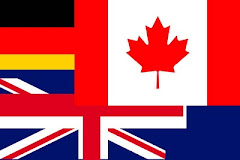At the beginning of the year during the Carnival of Genealogy, we were asked what were our goals for the year. I only set two. One was for the first nine months and the other for the last three months. Here is the first goal.
Goal 1: Complete the book on the Soldiers from Knox United (then Presbyterian) in the First World War. Most of the research is done, I think. I may find out differently when I go to work on writing about each one. I have started the writing on about four or five. There are 23 men involved with two being siblings.
Plan: To focus on one a week, finishing research and writing. That will take me to the end of June.
To decide how I am going to publish it and distribute it. It is not meant to be for a large distribution but I wanted the information about them in writing so that it is preserved for future generations.
Publish by September 14, 2011 (92 years after the organ was dedicated in memory of these men).
So, how am I doing. I am doing really well. I am almost finished all the writing. I have finished all but one man. I have included some church history. My sister has done copy editing of what I have given her. I do keep looking at it to make sure I am happy with everything.
At the end of last week, I downloaded a software (free version) that reads back what you have written. It is good to hear what you have read out loud. It is called to
Natural Reader. I had done a search on the Internet to see what is available that I could try. [Warning that when you go to the site it will have a voice explaining that software.] Have you tried any? How are you using them?
I found it good to hear someone read it as I did another run through of what I had written. I went through about one half of the introductions to the soldiers. I will likely go through the last half today or tomorrow.
What I have left to do this week:
1. Finish writing about the one soldier -
Alexander McKay Gunn - I wrote about him when I discussed Elizabeth Shown Mills - FAN club methodology. In it I talked about information that I learned about other people in the documents. In Alexander's obituary, it says that his parents died when he was young. Now, I had found the death of his mother when Alexander was only two weeks old. What happened to his father and why did he end up with his aunts? Where was his older sister, Bessie?
I found a marriage for a John Gunn to a Margaret Ireland 7 December 1887. [1] I thought it was likely Alexander's father but I wasn't a 100% sure. I also found a John Gunn with wife Margaret in the 1891 census. In the household, there are the following people: John, 45; Margaret, 34; Betsy, 9; Christena, 2; John 7/12 and Betsy, 84. [2]
It is Bessie's obituary that made me realize that the above must be the correct family. I found her obituary in volume 1 of the "Surname Collection" prepared by the Bruce Grey Branch of the Ontario Genealogical Society and put on microfiche. The date written on it is 20 April 56. It mentions her brother, Alexander McKay Gunn, being killed in action in 1917. It mentions a brother Wesley Gunn of Sault Ste. Marie, a sister, Christina, Mrs. George Harbottle of Sault Ste. Marie and another brother who predeceased her, John Gunn of Richard's Landing.[3]
Having found Bessie's obituary, I feel that I can add the information about her father's second family.
[I have now finished Alexander Gunn's section with information that I have presented here.]
2. Write about the church organ's history and its connection to this project.
3. Find more photographs if I can.
4. Finish putting it together.
5. Indexing
6. Have it proofread
7. Finish getting it ready for printing.
Although, there is still work to be done, I am on track with my planned schedule.
[1] John Gunn – Margaret Ireland Ontario marriage registration 004137 (7 December 1887); digital image,
Ancestry.ca (http://www.ancestry.ca : accessed 12 April 2011), citing microfilm MS 932 reel 56, Archives of Ontario,
Toronto.
[2] 1891 Census of Canada, Ontario, North Grey (district 68), Keppel (sub-district A), division 2, p. 25, family 2, John Gunn household; digital image, Ancestry.ca (http://www.ancestry.ca : accessed 10 June 2011), citing microfilm, T-6338, Library and Archives Canada, Ottawa.
[3] “Mrs. Leslie Penner Dies in Hospital,” [
Owen Sound Sun-Times, 20 April 1956] in Bruce Grey Branch Ontario Genealogical Society, “Surname Collection” [microfiche]
Note: I have no connection to the software company that created Natural Reader.
© 2011 Janet Iles


















